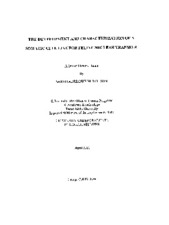| dc.creator | Hutchison, Sarah Adrianne | |
| dc.date.accessioned | 2013-02-22T20:40:41Z | |
| dc.date.available | 2013-02-22T20:40:41Z | |
| dc.date.created | 2000 | |
| dc.date.issued | 2013-02-22 | |
| dc.identifier.uri | https://hdl.handle.net/1969.1/ETD-TAMU-2000-Fellows-Thesis-H885 | |
| dc.description | Due to the character of the original source materials and the nature of batch digitization, quality control issues may be present in this document. Please report any quality issues you encounter to digital@library.tamu.edu, referencing the URI of the item. | en |
| dc.description | Includes bibliographical references (leaves 24-27). | en |
| dc.description.abstract | Nuclear transfer is fast becoming an alternative method for reproduction, and it is useful in producing genetically identical animals. This study was designed to develop and characterize a cell line which may be possible to use in nuclear transfer in felines. Cells which are useful for nuclear transfer must be synchronized with the oocyte being fused in order to prevent possible aneuploidy due to high MPF in oocytes arrested in metaphase II. Granulosa cells were collected from cat ovaries and grown in culture. After a few passages, cells were analyzed by using flow cytometry (FACS) to evaluate their stage in the cell cycle and their ploidy. Cells from passages up to passage 2 were analyzed as well as freshly collected granulosa cells. Also, serum-starved cells and regularly fed cells from passage 1 were compared. It was found that the freshly collected cells had the highest percentage of cells in G0/G1 (89%), suggesting they may be useful for nuclear transfer. However, cells in culture exhibited the highest number of cells in G0/G1 at passage 2. Also, serum starved cells were significantly more synchronized in G0/G1 than regularly fed cells, as expected (85% compared to 70%). It appears as though cells in passage 2, which have been synchronized using serum-starvation, are the best candidates for nuclear transfer. Serum-starved cells from passage 2 are currently being used in nuclear transfer, but so far only pathenodes (up to 28 "cells") have resulted. | en |
| dc.format.medium | electronic | en |
| dc.format.mimetype | application/pdf | |
| dc.language.iso | en_US | |
| dc.publisher | Texas A&M University | |
| dc.rights | This thesis was part of a retrospective digitization project authorized by the Texas A&M University Libraries in 2008. Copyright remains vested with the author(s). It is the user's responsibility to secure permission from the copyright holder(s) for re-use of the work beyond the provision of Fair Use. | en |
| dc.subject | cell biology I. | en |
| dc.subject | Major cell biology I. | en |
| dc.title | The development and characterization of a somatic cell line for feline nuclear transfer | en |
| thesis.degree.department | cell biology I | en |
| thesis.degree.discipline | cell biology I | en |
| thesis.degree.name | Fellows Thesis | en |
| thesis.degree.level | Undergraduate | en |
| dc.type.genre | thesis | en |
| dc.type.material | text | en |
| dc.format.digitalOrigin | reformatted digital | en |


